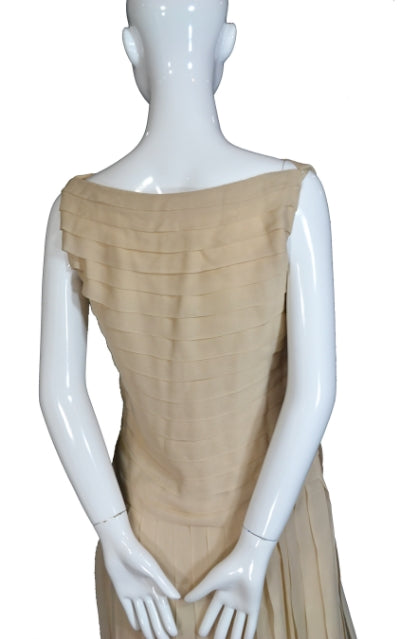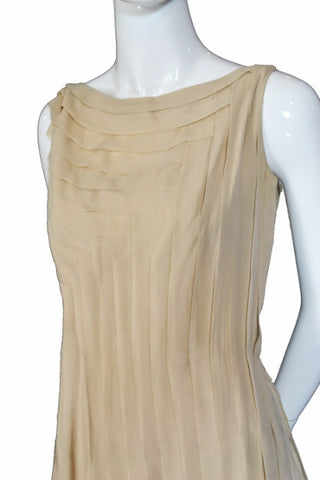
I don't like the word hate so I use it rarely and very selectively, I hate SEO. For those of you who don't know, those initials stand for "search engine optimization." It's what those of us who own websites have to be constantly aware of in order for customers using search engines to find us on the web. If I am selling a Balenciaga vintage dress, I have to make sure that the right "keyword phrases" are in the description in the right order so that Google, or Bing, or whatever other search engine you use, can find it.
I can spend hours writing paragraphs describing the fabric, construction, and history of the dress, but if I don't have the right words, or the right description on the images, it won't matter.
No one will ever find it.
I will admit it, I am a failure at SEO. I'm just not interested in focusing on how to make search engines love me, I'm not a computer professional, I am a vintage clothing professional. I'm more interested in finding and selling beautiful vintage clothing but instead, I have to spend the majority of my time on Key words, meta descriptions,getting inbound links, etc.. etc.. etc.. I resent having to do that and can't keep up with changing algorithms, spiders, blah blah blah. It bores me to even tell you about it all.

There are two reasons I will probably never be able to sell one of the most beautiful vintage dresses I have ever owned. The first is that American consumers are more focused on trend and status than on quality. Nothing is more depressing to me than to look at all of the "my style" pages on Pinterest and discover that everyone basically has the same style. Slouchy tops, skinny pants, big hats.. you know what I'm talking about! I think they believe that they have original style, but sadly, they are all pretty generic. Another depressing observation: A worn, used, famous logo handbag, often made of cloth or vinyl, will sell quicker and for ten times the amount than that of an unused, gorgeous leather vintage handbag made in Italy in perfect condition designed by someone who fell off of the fashion radar. Even in person, when the quality is hands down better than one of the "designer" pieces, customers will choose the logo every time. Well, almost every time. There are those few, rare, incredible consumers who appreciate design, quality and fine fabric. They have a fashion "confidence" and a true understanding of what looks best on them, in spite of trend, and will buy beautiful pieces regardless of the label. I've met some women like that and am always impressed - they look better than anyone in the room. But selling online doesn't allow even those rare customers to appreciate a dress like this.

This dress was acquired from the estate of a woman who purchased some of the finest clothing I have ever had the privilege of selling. She bought clothing from the 1950's through the 1970s and I believe this is from the 1960's. When I evaluate estates, it's an interesting exercise in observing human behavior. Often, I have noticed that, even women who previously owned nothing but the finest couture clothing will ultimately choose comfort over style and start wearing more "practical" clothing as they get much older. But this woman stayed true to her design aesthetic throughout her life. The result was an amazing, impressive collection that was in impeccable condition.

I almost cried when I opened her closet doors and I actually purchased her entire estate of clothing and accessories. I have never found one quite like it again. Her closet read like a 'who's who" of important mid 20th century designers; Jacques Fath, Lanvin, Chanel, Ceil Chapman, Christian Dior, Balenciaga, Givenchy, Nina Ricci, Courreges, Pierre Cardin, Jacques Heim, Norman Norell, Hermes, Yves Saint Laurent, Schiaparelli, and Valentino. She bought a lot in Paris and New York, and sometimes, as in the case of this dress, removed labels if they bothered her. Sometimes, the labels would be in the pockets or pinned to the hangers, but this dress was truly anonymous. The fabric us an ultra fine buff silk chiffon over a very pale peach, almost skin tone, built in slip. Sometimes it takes on the peach cast from the slip and it moves in ripples with the lightness of a feather. The pleating is phenomenal, going in different directions like an intricate maze.The dress appears to be simple when you first see it, but when you look closely, and feel the luxuriously sublime fabric, you understand that you are in the presence of fashion design perfection.

The second reason I will probably never sell this dress takes us back to the beginning of the post - SEO. Since I can't put in the right "keywords" or put an important searchable name like "Chanel" into the "Meta Description" this dress won't make it on search result pages. The lack of a recognizable important label would make it almost impossible to find. I have had some museum professionals from a couple of different fashion museums attribute it to very famous designers, but no one can agree on who designed this remarkable piece. The one thing everyone agrees on is that it is spectacular and had to have been created by a masterful designer. But Google doesn't know that.

If I could, I would invite customers to my studio, cover all of the labels on every piece I own, and see how their buying patterns would change. If you weren't aware of particular designer collections, would you still pick the same pieces? It's good to "check" ourselves when it comes to fashion - we need to make sure we are buying what we love and what looks good on our body types, regardless of labels or trend. That challenge is particularly difficult in this rabid "next biggest thing" world in which we live.

So here is my fashion challenge to those of you who dare to accept it: It ends up being an ethical fashion challenge in some ways too! Ignore labels and trends, don't pay attention to what celebrities are wearing and buy beautiful and well made things. Pay attention to fit, finishing quality, fabric ( I would personally prefer that the fabric be made of natural fibers), and most importantly, make sure you feel beautiful when you wear it! You might have to buy vintage to make it work within your budget and you won't find these pieces in a day. Finding the right clothing might take weeks, or months, but when you find that dress, or that coat, or that blouse, that is perfect for you, you will most likely keep it for a lifetime.

